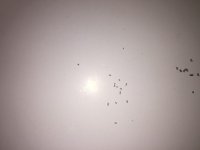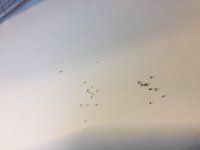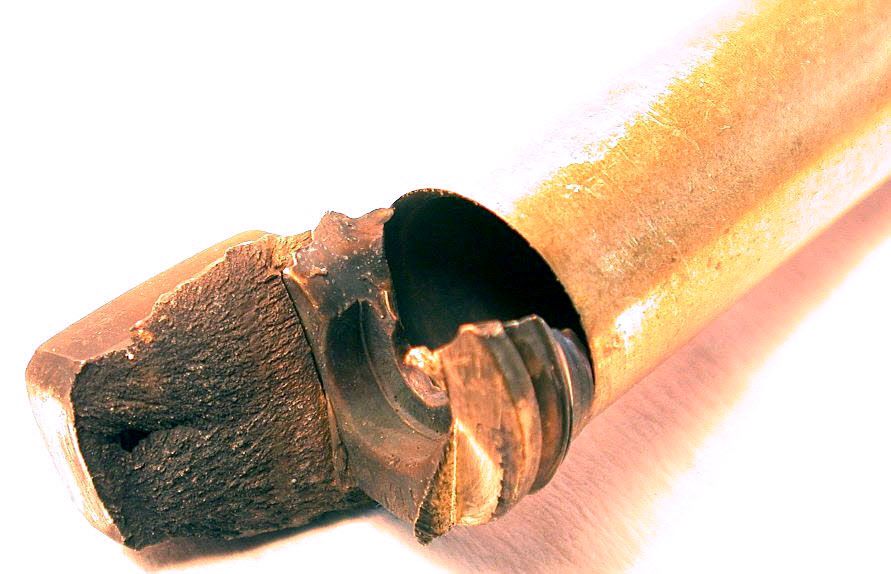Jonnefudge,
Yes, the whiter grains are mostly-unburned grains that the graphite coating has burned off of before they extinguished. When you are operating at a pressure too low for the powder to burn efficiently (the slower the powder, the higher the pressure needed for clean, efficient burn), there is a phenomenon in which the bullet gets going down the barrel too fast for the powder to make gas quickly enough to keep up with the rate of the resulting volume expansion. This is especially easy to have happen using a straight wall cartridge because the bullet doesn't have to move very far to double the volume the powder is burning in. The rate of expansion of that volume is high in such a chambering, and the total expansion ratio is high, too. As a result, the pressure drops and powder material that has changed phase to vapor, which happens just before it burns, instead then re-condenses, dropping pressure and temperature further so that it extinguishes. This is described in the current Norma manual.
The extinguishing happens to some small extent with most powders when they exit the muzzle and pressure drops while they are still inside the oxygen starved muzzle blast sphere (the surface of which has the fireball, but nothing is burning under that surface flame). It was pointed out to me by board member Hummer70, who worked as a test director at Aberdeen Proving Grounds, that you can sweep up the dust in front of the firing point at any indoor range and touch a match to it and it will flare up and burn as smokeless powder does.
The problem with letting this extinguishing go so far as to leave those pale grains all over your bore is that such a large degree of non-combustion can be associated with some weird pressure spike phenomena. It is not entirely understood, but you can get localized pressure to drop, then have ignition return as a wave of gas travels from the breech forward and that creates very high local pressure near the bullet base position. The result is like short seating in a muzzle loader where the ball is way out in front of the powder charge which burns and launches its own mass forward against the ball, bulging the barrel at impact with it. In this sense, it's like shooting into an obstruction. With smokeless powder involved, barrel ringing and, worst case, blowing off, as Texas gunsmith Charlie Sisk has been able to demonstrate on demand with .338's, are all possible.
Below is a strain gauge reading of a commercial load with a lot of underburning powder. The pressure jump at the end is actually a traveling wave that came back from the site of the pressure jump to the breech, where the gauges were located. Standard copper crushers and commercial test barrel pressure transducers don't see this wave because they move with the steel. They would need to be located forward in the barrel where the spike actually occurs to see it. But strain gauges measure the stretch of the steel, so they see it just fine.
Reproduced with permission from Jim Ristow at RSI:
So, If you want to continue to experiment with underloading a powder too slow for the peak pressures you want to fire it at, I would consider investing in
the pressure equipment to be sure to avoid damaging the gun. If you are on a budget, however, you should move to a faster powder. The unburned grains are wasted powder, meaning you now are using a higher charge weight and eating through your powder budget faster than you need to anyway. A faster powder will achieve the same velocity with a smaller quantity that peaks at a little bit higher pressure.
As an example, if your COL is 2.550", then QuickLOAD thinks your Norma 200 load is running at around 12,000 psi peak, dropping and 2800 psi at the muzzle and getting about 1400 fps. If you switched to 16.5 grains of Unique, your peak pressure would go up to 23,700 psi and your muzzle pressure would fall to 1500 psi, with resulting identical muzzle velocity, but you would be getting 424 shots per pound instead of just 194 shots per pound as you are from the Norma 200. The powder will burn much more completely and fouling residue will thereby be reduced. It won't be zero, but it will be less.




